Reducing Heart Failure Admissions: A Study of Self-Care Strategies
VerifiedAdded on 2023/06/11
|8
|1980
|212
Essay
AI Summary
This essay explores the rising healthcare burden of heart failure (HF) and strategies to reduce hospital readmissions, aligning with the Healthy People 2020 initiative's goal to decrease hospitalizations for adults aged 65-74 with HF. It highlights the significant impact of HF on the Medicare program and the importance of addressing readmissions. The essay discusses the effectiveness of self-care strategies, such as daily weight monitoring and participation in outpatient interdisciplinary HF classes, in reducing HF-related admissions. Studies have shown that patient education and training in self-care can help detect symptoms of worsening HF and improve outcomes, emphasizing the importance of thorough discharge planning and patient involvement. The essay concludes that educating patients in self-care is a key method for reducing HF admissions and improving the healthcare system.
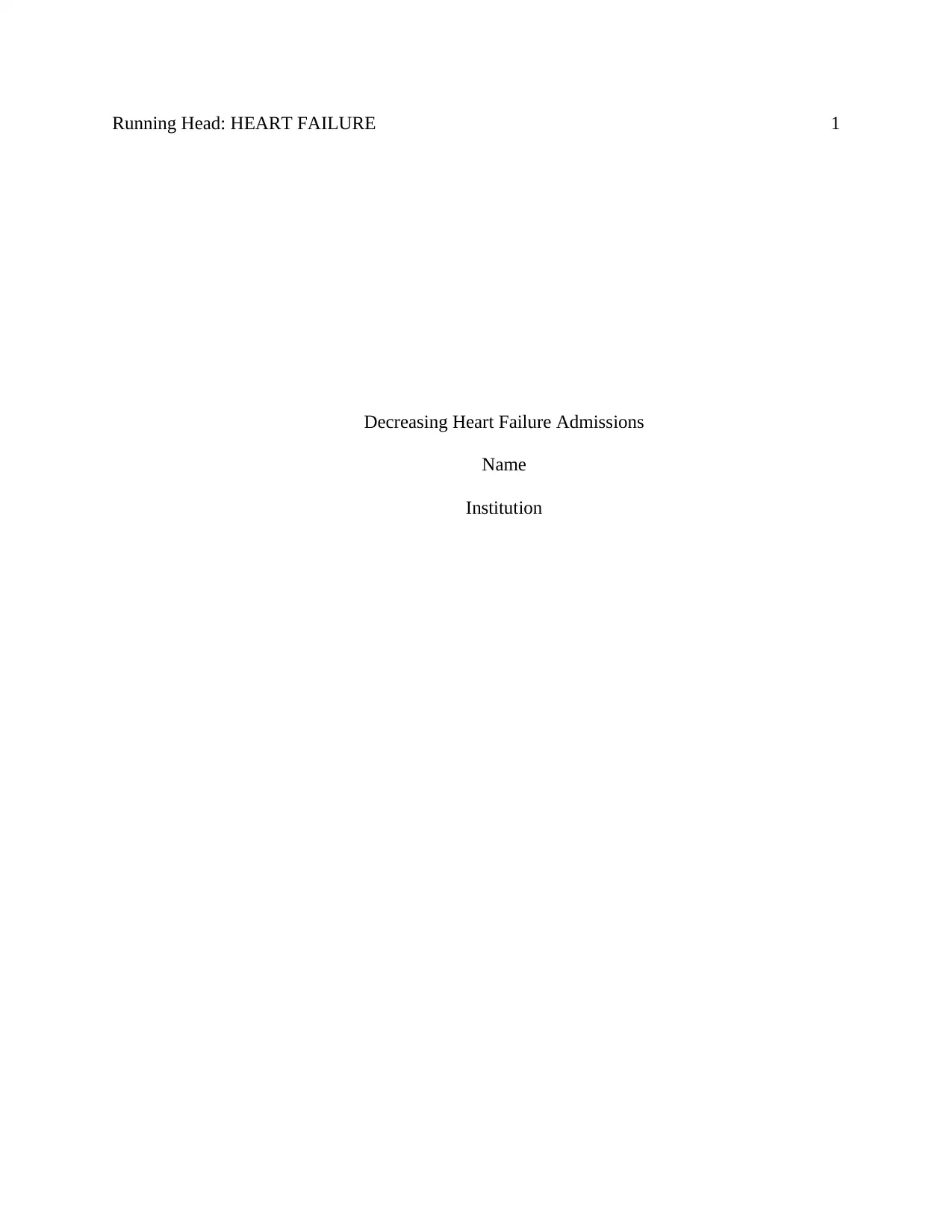
Running Head: HEART FAILURE 1
Decreasing Heart Failure Admissions
Name
Institution
Decreasing Heart Failure Admissions
Name
Institution
Paraphrase This Document
Need a fresh take? Get an instant paraphrase of this document with our AI Paraphraser
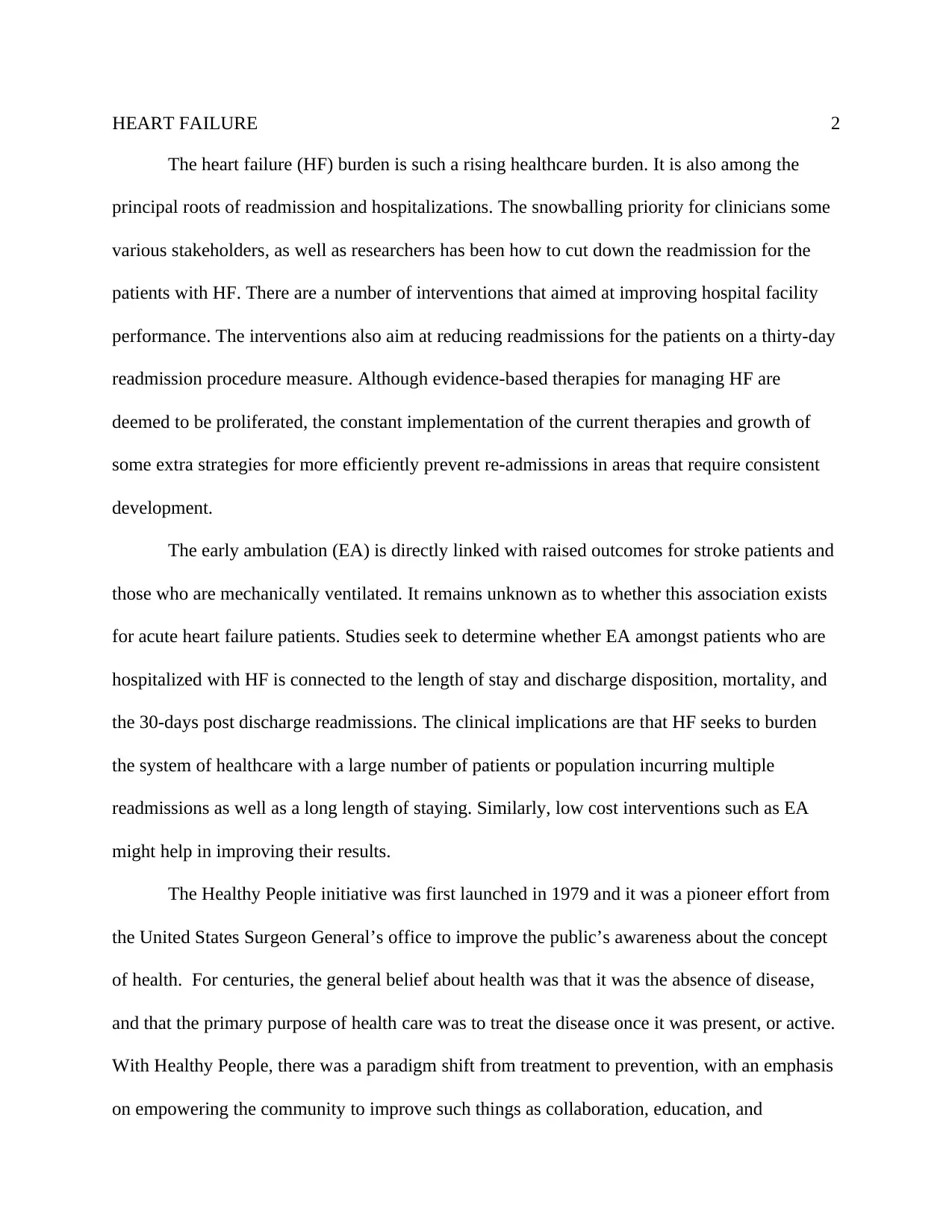
HEART FAILURE 2
The heart failure (HF) burden is such a rising healthcare burden. It is also among the
principal roots of readmission and hospitalizations. The snowballing priority for clinicians some
various stakeholders, as well as researchers has been how to cut down the readmission for the
patients with HF. There are a number of interventions that aimed at improving hospital facility
performance. The interventions also aim at reducing readmissions for the patients on a thirty-day
readmission procedure measure. Although evidence-based therapies for managing HF are
deemed to be proliferated, the constant implementation of the current therapies and growth of
some extra strategies for more efficiently prevent re-admissions in areas that require consistent
development.
The early ambulation (EA) is directly linked with raised outcomes for stroke patients and
those who are mechanically ventilated. It remains unknown as to whether this association exists
for acute heart failure patients. Studies seek to determine whether EA amongst patients who are
hospitalized with HF is connected to the length of stay and discharge disposition, mortality, and
the 30-days post discharge readmissions. The clinical implications are that HF seeks to burden
the system of healthcare with a large number of patients or population incurring multiple
readmissions as well as a long length of staying. Similarly, low cost interventions such as EA
might help in improving their results.
The Healthy People initiative was first launched in 1979 and it was a pioneer effort from
the United States Surgeon General’s office to improve the public’s awareness about the concept
of health. For centuries, the general belief about health was that it was the absence of disease,
and that the primary purpose of health care was to treat the disease once it was present, or active.
With Healthy People, there was a paradigm shift from treatment to prevention, with an emphasis
on empowering the community to improve such things as collaboration, education, and
The heart failure (HF) burden is such a rising healthcare burden. It is also among the
principal roots of readmission and hospitalizations. The snowballing priority for clinicians some
various stakeholders, as well as researchers has been how to cut down the readmission for the
patients with HF. There are a number of interventions that aimed at improving hospital facility
performance. The interventions also aim at reducing readmissions for the patients on a thirty-day
readmission procedure measure. Although evidence-based therapies for managing HF are
deemed to be proliferated, the constant implementation of the current therapies and growth of
some extra strategies for more efficiently prevent re-admissions in areas that require consistent
development.
The early ambulation (EA) is directly linked with raised outcomes for stroke patients and
those who are mechanically ventilated. It remains unknown as to whether this association exists
for acute heart failure patients. Studies seek to determine whether EA amongst patients who are
hospitalized with HF is connected to the length of stay and discharge disposition, mortality, and
the 30-days post discharge readmissions. The clinical implications are that HF seeks to burden
the system of healthcare with a large number of patients or population incurring multiple
readmissions as well as a long length of staying. Similarly, low cost interventions such as EA
might help in improving their results.
The Healthy People initiative was first launched in 1979 and it was a pioneer effort from
the United States Surgeon General’s office to improve the public’s awareness about the concept
of health. For centuries, the general belief about health was that it was the absence of disease,
and that the primary purpose of health care was to treat the disease once it was present, or active.
With Healthy People, there was a paradigm shift from treatment to prevention, with an emphasis
on empowering the community to improve such things as collaboration, education, and
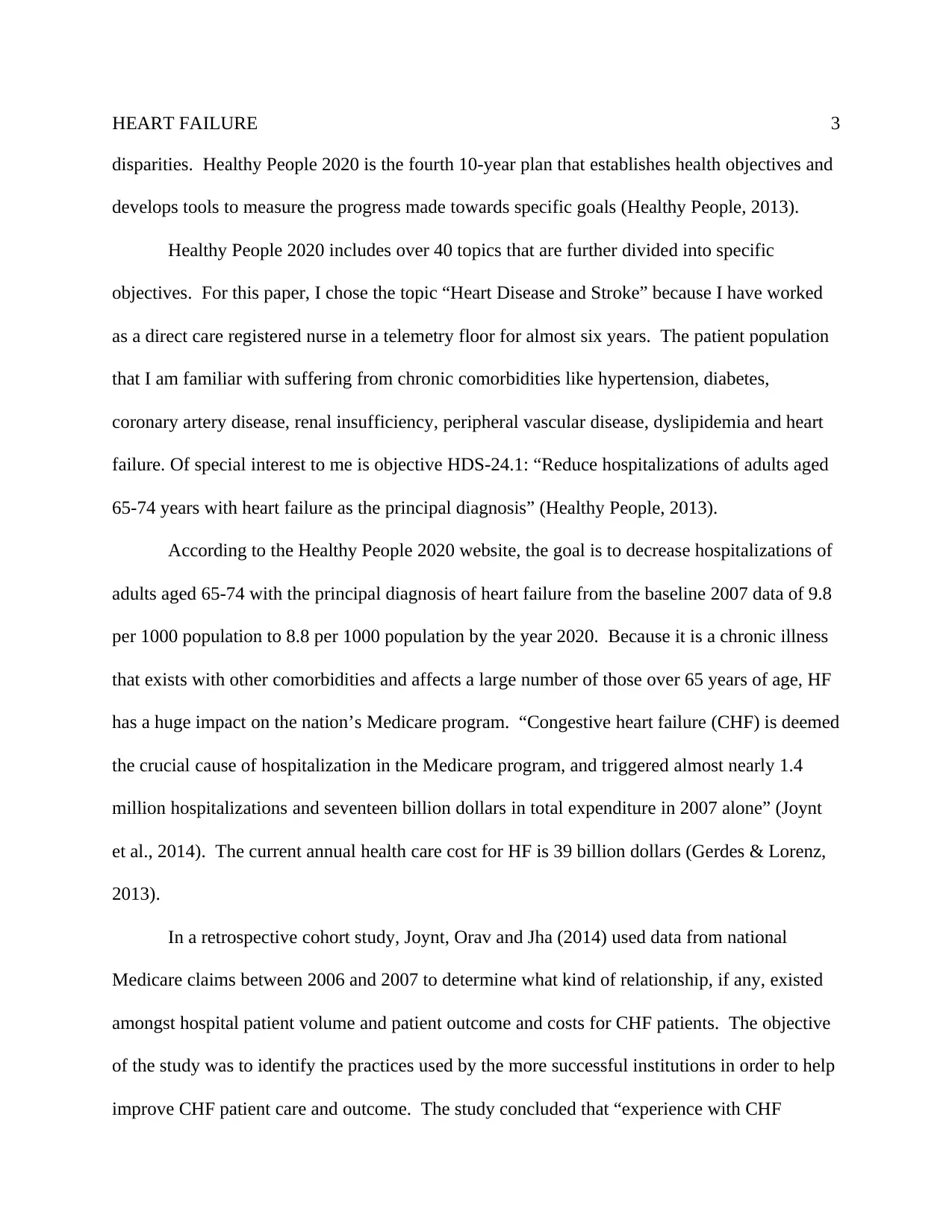
HEART FAILURE 3
disparities. Healthy People 2020 is the fourth 10-year plan that establishes health objectives and
develops tools to measure the progress made towards specific goals (Healthy People, 2013).
Healthy People 2020 includes over 40 topics that are further divided into specific
objectives. For this paper, I chose the topic “Heart Disease and Stroke” because I have worked
as a direct care registered nurse in a telemetry floor for almost six years. The patient population
that I am familiar with suffering from chronic comorbidities like hypertension, diabetes,
coronary artery disease, renal insufficiency, peripheral vascular disease, dyslipidemia and heart
failure. Of special interest to me is objective HDS-24.1: “Reduce hospitalizations of adults aged
65-74 years with heart failure as the principal diagnosis” (Healthy People, 2013).
According to the Healthy People 2020 website, the goal is to decrease hospitalizations of
adults aged 65-74 with the principal diagnosis of heart failure from the baseline 2007 data of 9.8
per 1000 population to 8.8 per 1000 population by the year 2020. Because it is a chronic illness
that exists with other comorbidities and affects a large number of those over 65 years of age, HF
has a huge impact on the nation’s Medicare program. “Congestive heart failure (CHF) is deemed
the crucial cause of hospitalization in the Medicare program, and triggered almost nearly 1.4
million hospitalizations and seventeen billion dollars in total expenditure in 2007 alone” (Joynt
et al., 2014). The current annual health care cost for HF is 39 billion dollars (Gerdes & Lorenz,
2013).
In a retrospective cohort study, Joynt, Orav and Jha (2014) used data from national
Medicare claims between 2006 and 2007 to determine what kind of relationship, if any, existed
amongst hospital patient volume and patient outcome and costs for CHF patients. The objective
of the study was to identify the practices used by the more successful institutions in order to help
improve CHF patient care and outcome. The study concluded that “experience with CHF
disparities. Healthy People 2020 is the fourth 10-year plan that establishes health objectives and
develops tools to measure the progress made towards specific goals (Healthy People, 2013).
Healthy People 2020 includes over 40 topics that are further divided into specific
objectives. For this paper, I chose the topic “Heart Disease and Stroke” because I have worked
as a direct care registered nurse in a telemetry floor for almost six years. The patient population
that I am familiar with suffering from chronic comorbidities like hypertension, diabetes,
coronary artery disease, renal insufficiency, peripheral vascular disease, dyslipidemia and heart
failure. Of special interest to me is objective HDS-24.1: “Reduce hospitalizations of adults aged
65-74 years with heart failure as the principal diagnosis” (Healthy People, 2013).
According to the Healthy People 2020 website, the goal is to decrease hospitalizations of
adults aged 65-74 with the principal diagnosis of heart failure from the baseline 2007 data of 9.8
per 1000 population to 8.8 per 1000 population by the year 2020. Because it is a chronic illness
that exists with other comorbidities and affects a large number of those over 65 years of age, HF
has a huge impact on the nation’s Medicare program. “Congestive heart failure (CHF) is deemed
the crucial cause of hospitalization in the Medicare program, and triggered almost nearly 1.4
million hospitalizations and seventeen billion dollars in total expenditure in 2007 alone” (Joynt
et al., 2014). The current annual health care cost for HF is 39 billion dollars (Gerdes & Lorenz,
2013).
In a retrospective cohort study, Joynt, Orav and Jha (2014) used data from national
Medicare claims between 2006 and 2007 to determine what kind of relationship, if any, existed
amongst hospital patient volume and patient outcome and costs for CHF patients. The objective
of the study was to identify the practices used by the more successful institutions in order to help
improve CHF patient care and outcome. The study concluded that “experience with CHF
⊘ This is a preview!⊘
Do you want full access?
Subscribe today to unlock all pages.

Trusted by 1+ million students worldwide
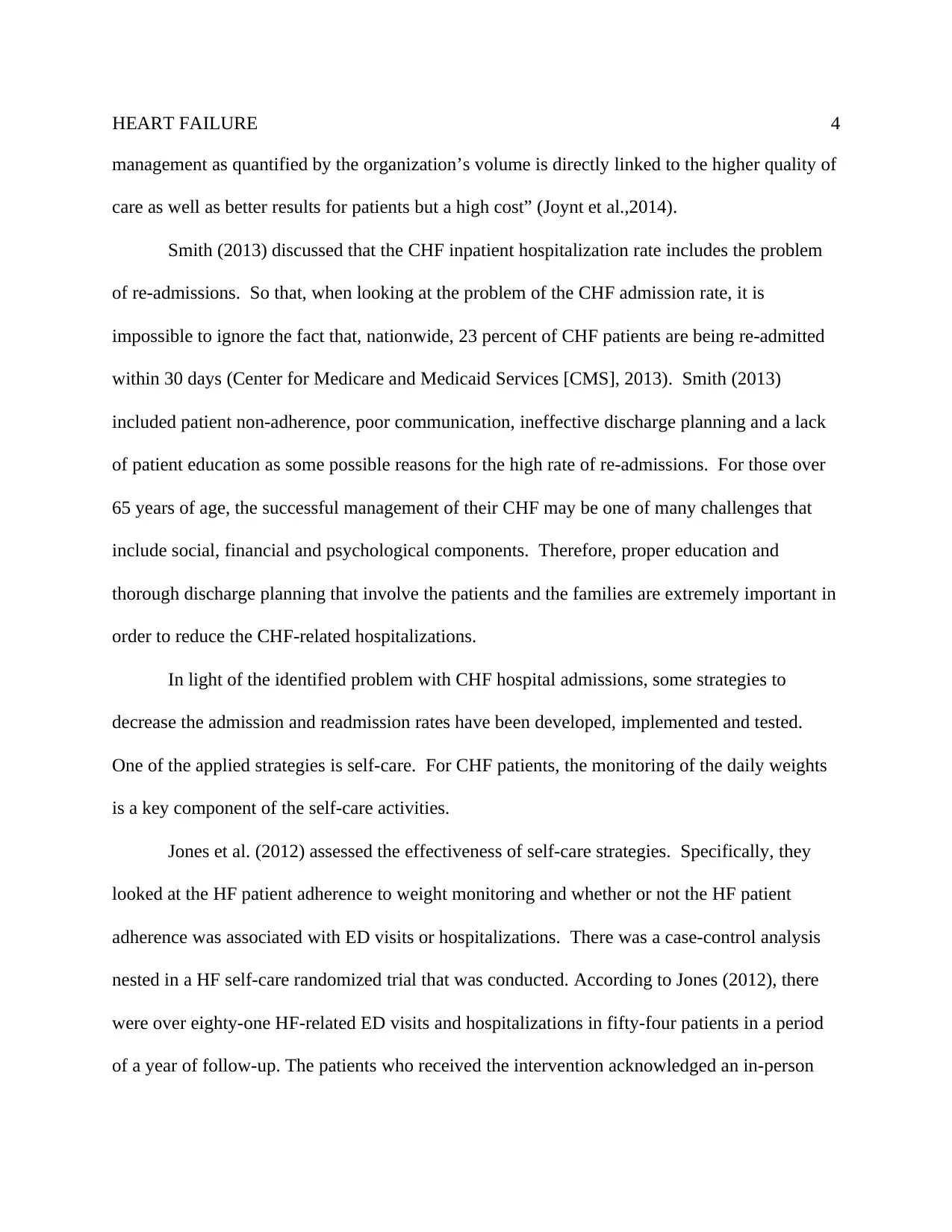
HEART FAILURE 4
management as quantified by the organization’s volume is directly linked to the higher quality of
care as well as better results for patients but a high cost” (Joynt et al.,2014).
Smith (2013) discussed that the CHF inpatient hospitalization rate includes the problem
of re-admissions. So that, when looking at the problem of the CHF admission rate, it is
impossible to ignore the fact that, nationwide, 23 percent of CHF patients are being re-admitted
within 30 days (Center for Medicare and Medicaid Services [CMS], 2013). Smith (2013)
included patient non-adherence, poor communication, ineffective discharge planning and a lack
of patient education as some possible reasons for the high rate of re-admissions. For those over
65 years of age, the successful management of their CHF may be one of many challenges that
include social, financial and psychological components. Therefore, proper education and
thorough discharge planning that involve the patients and the families are extremely important in
order to reduce the CHF-related hospitalizations.
In light of the identified problem with CHF hospital admissions, some strategies to
decrease the admission and readmission rates have been developed, implemented and tested.
One of the applied strategies is self-care. For CHF patients, the monitoring of the daily weights
is a key component of the self-care activities.
Jones et al. (2012) assessed the effectiveness of self-care strategies. Specifically, they
looked at the HF patient adherence to weight monitoring and whether or not the HF patient
adherence was associated with ED visits or hospitalizations. There was a case-control analysis
nested in a HF self-care randomized trial that was conducted. According to Jones (2012), there
were over eighty-one HF-related ED visits and hospitalizations in fifty-four patients in a period
of a year of follow-up. The patients who received the intervention acknowledged an in-person
management as quantified by the organization’s volume is directly linked to the higher quality of
care as well as better results for patients but a high cost” (Joynt et al.,2014).
Smith (2013) discussed that the CHF inpatient hospitalization rate includes the problem
of re-admissions. So that, when looking at the problem of the CHF admission rate, it is
impossible to ignore the fact that, nationwide, 23 percent of CHF patients are being re-admitted
within 30 days (Center for Medicare and Medicaid Services [CMS], 2013). Smith (2013)
included patient non-adherence, poor communication, ineffective discharge planning and a lack
of patient education as some possible reasons for the high rate of re-admissions. For those over
65 years of age, the successful management of their CHF may be one of many challenges that
include social, financial and psychological components. Therefore, proper education and
thorough discharge planning that involve the patients and the families are extremely important in
order to reduce the CHF-related hospitalizations.
In light of the identified problem with CHF hospital admissions, some strategies to
decrease the admission and readmission rates have been developed, implemented and tested.
One of the applied strategies is self-care. For CHF patients, the monitoring of the daily weights
is a key component of the self-care activities.
Jones et al. (2012) assessed the effectiveness of self-care strategies. Specifically, they
looked at the HF patient adherence to weight monitoring and whether or not the HF patient
adherence was associated with ED visits or hospitalizations. There was a case-control analysis
nested in a HF self-care randomized trial that was conducted. According to Jones (2012), there
were over eighty-one HF-related ED visits and hospitalizations in fifty-four patients in a period
of a year of follow-up. The patients who received the intervention acknowledged an in-person
Paraphrase This Document
Need a fresh take? Get an instant paraphrase of this document with our AI Paraphraser
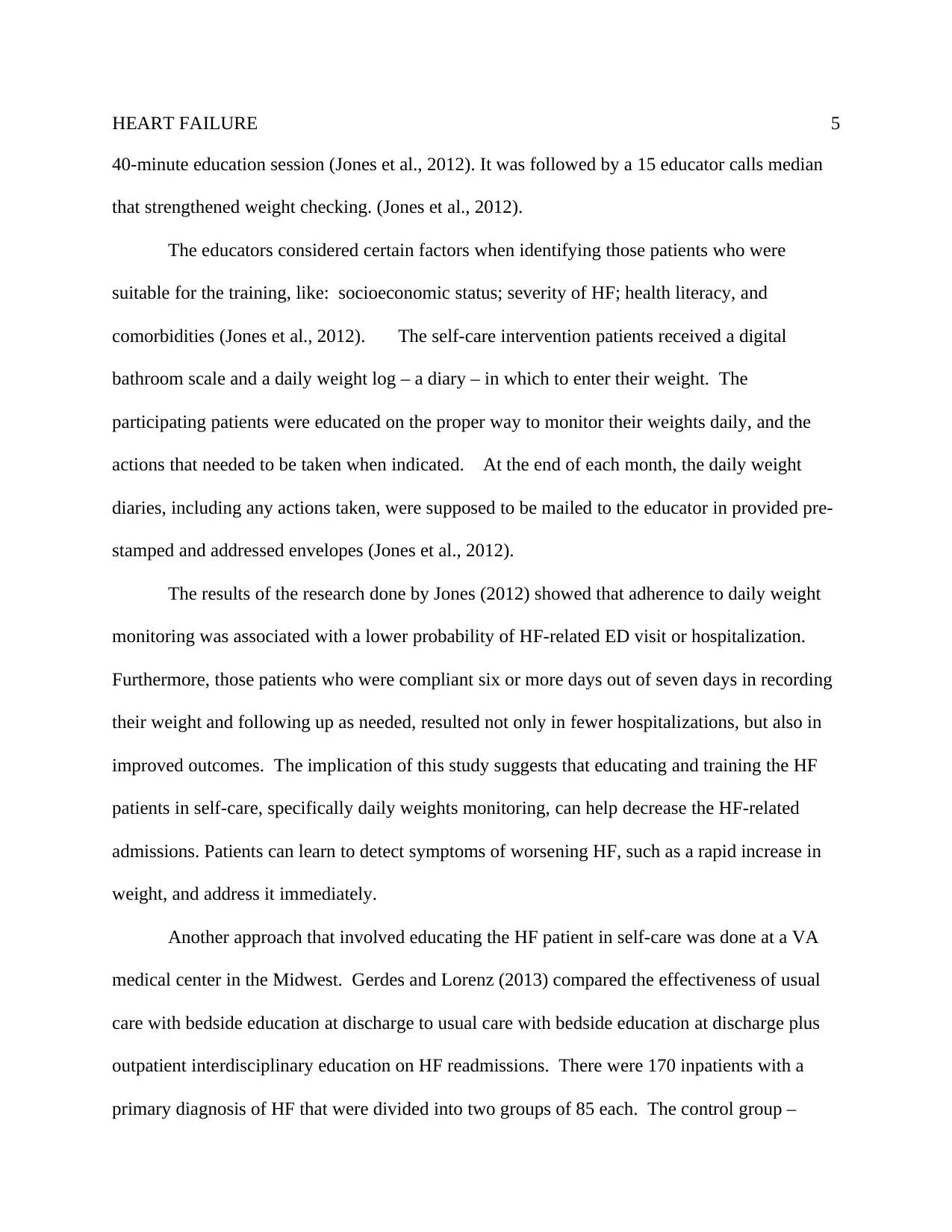
HEART FAILURE 5
40-minute education session (Jones et al., 2012). It was followed by a 15 educator calls median
that strengthened weight checking. (Jones et al., 2012).
The educators considered certain factors when identifying those patients who were
suitable for the training, like: socioeconomic status; severity of HF; health literacy, and
comorbidities (Jones et al., 2012). The self-care intervention patients received a digital
bathroom scale and a daily weight log – a diary – in which to enter their weight. The
participating patients were educated on the proper way to monitor their weights daily, and the
actions that needed to be taken when indicated. At the end of each month, the daily weight
diaries, including any actions taken, were supposed to be mailed to the educator in provided pre-
stamped and addressed envelopes (Jones et al., 2012).
The results of the research done by Jones (2012) showed that adherence to daily weight
monitoring was associated with a lower probability of HF-related ED visit or hospitalization.
Furthermore, those patients who were compliant six or more days out of seven days in recording
their weight and following up as needed, resulted not only in fewer hospitalizations, but also in
improved outcomes. The implication of this study suggests that educating and training the HF
patients in self-care, specifically daily weights monitoring, can help decrease the HF-related
admissions. Patients can learn to detect symptoms of worsening HF, such as a rapid increase in
weight, and address it immediately.
Another approach that involved educating the HF patient in self-care was done at a VA
medical center in the Midwest. Gerdes and Lorenz (2013) compared the effectiveness of usual
care with bedside education at discharge to usual care with bedside education at discharge plus
outpatient interdisciplinary education on HF readmissions. There were 170 inpatients with a
primary diagnosis of HF that were divided into two groups of 85 each. The control group –
40-minute education session (Jones et al., 2012). It was followed by a 15 educator calls median
that strengthened weight checking. (Jones et al., 2012).
The educators considered certain factors when identifying those patients who were
suitable for the training, like: socioeconomic status; severity of HF; health literacy, and
comorbidities (Jones et al., 2012). The self-care intervention patients received a digital
bathroom scale and a daily weight log – a diary – in which to enter their weight. The
participating patients were educated on the proper way to monitor their weights daily, and the
actions that needed to be taken when indicated. At the end of each month, the daily weight
diaries, including any actions taken, were supposed to be mailed to the educator in provided pre-
stamped and addressed envelopes (Jones et al., 2012).
The results of the research done by Jones (2012) showed that adherence to daily weight
monitoring was associated with a lower probability of HF-related ED visit or hospitalization.
Furthermore, those patients who were compliant six or more days out of seven days in recording
their weight and following up as needed, resulted not only in fewer hospitalizations, but also in
improved outcomes. The implication of this study suggests that educating and training the HF
patients in self-care, specifically daily weights monitoring, can help decrease the HF-related
admissions. Patients can learn to detect symptoms of worsening HF, such as a rapid increase in
weight, and address it immediately.
Another approach that involved educating the HF patient in self-care was done at a VA
medical center in the Midwest. Gerdes and Lorenz (2013) compared the effectiveness of usual
care with bedside education at discharge to usual care with bedside education at discharge plus
outpatient interdisciplinary education on HF readmissions. There were 170 inpatients with a
primary diagnosis of HF that were divided into two groups of 85 each. The control group –
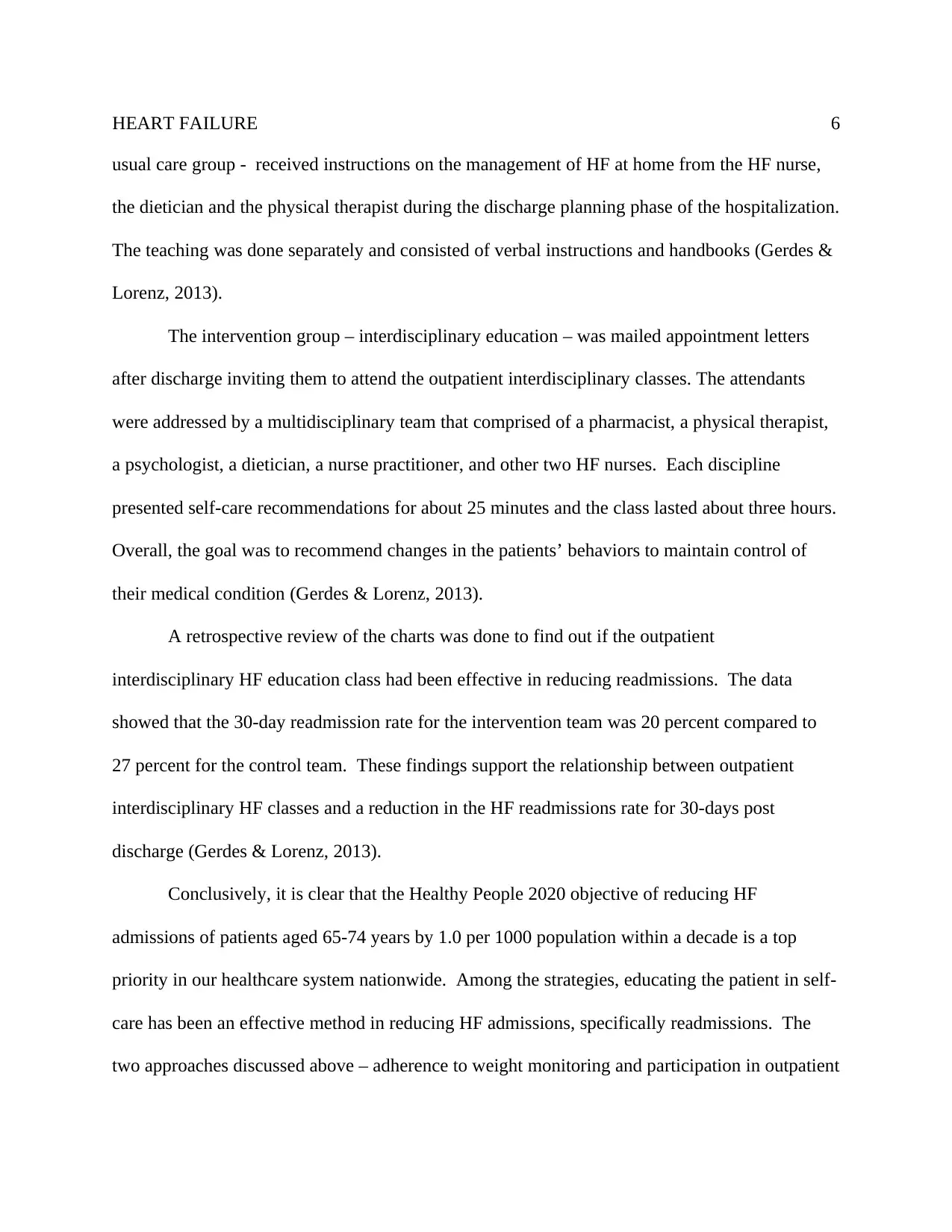
HEART FAILURE 6
usual care group - received instructions on the management of HF at home from the HF nurse,
the dietician and the physical therapist during the discharge planning phase of the hospitalization.
The teaching was done separately and consisted of verbal instructions and handbooks (Gerdes &
Lorenz, 2013).
The intervention group – interdisciplinary education – was mailed appointment letters
after discharge inviting them to attend the outpatient interdisciplinary classes. The attendants
were addressed by a multidisciplinary team that comprised of a pharmacist, a physical therapist,
a psychologist, a dietician, a nurse practitioner, and other two HF nurses. Each discipline
presented self-care recommendations for about 25 minutes and the class lasted about three hours.
Overall, the goal was to recommend changes in the patients’ behaviors to maintain control of
their medical condition (Gerdes & Lorenz, 2013).
A retrospective review of the charts was done to find out if the outpatient
interdisciplinary HF education class had been effective in reducing readmissions. The data
showed that the 30-day readmission rate for the intervention team was 20 percent compared to
27 percent for the control team. These findings support the relationship between outpatient
interdisciplinary HF classes and a reduction in the HF readmissions rate for 30-days post
discharge (Gerdes & Lorenz, 2013).
Conclusively, it is clear that the Healthy People 2020 objective of reducing HF
admissions of patients aged 65-74 years by 1.0 per 1000 population within a decade is a top
priority in our healthcare system nationwide. Among the strategies, educating the patient in self-
care has been an effective method in reducing HF admissions, specifically readmissions. The
two approaches discussed above – adherence to weight monitoring and participation in outpatient
usual care group - received instructions on the management of HF at home from the HF nurse,
the dietician and the physical therapist during the discharge planning phase of the hospitalization.
The teaching was done separately and consisted of verbal instructions and handbooks (Gerdes &
Lorenz, 2013).
The intervention group – interdisciplinary education – was mailed appointment letters
after discharge inviting them to attend the outpatient interdisciplinary classes. The attendants
were addressed by a multidisciplinary team that comprised of a pharmacist, a physical therapist,
a psychologist, a dietician, a nurse practitioner, and other two HF nurses. Each discipline
presented self-care recommendations for about 25 minutes and the class lasted about three hours.
Overall, the goal was to recommend changes in the patients’ behaviors to maintain control of
their medical condition (Gerdes & Lorenz, 2013).
A retrospective review of the charts was done to find out if the outpatient
interdisciplinary HF education class had been effective in reducing readmissions. The data
showed that the 30-day readmission rate for the intervention team was 20 percent compared to
27 percent for the control team. These findings support the relationship between outpatient
interdisciplinary HF classes and a reduction in the HF readmissions rate for 30-days post
discharge (Gerdes & Lorenz, 2013).
Conclusively, it is clear that the Healthy People 2020 objective of reducing HF
admissions of patients aged 65-74 years by 1.0 per 1000 population within a decade is a top
priority in our healthcare system nationwide. Among the strategies, educating the patient in self-
care has been an effective method in reducing HF admissions, specifically readmissions. The
two approaches discussed above – adherence to weight monitoring and participation in outpatient
⊘ This is a preview!⊘
Do you want full access?
Subscribe today to unlock all pages.

Trusted by 1+ million students worldwide

HEART FAILURE 7
HF classes- are of particular significance because the evidence shows that these two
interventions have decreased HF admission rates.
HF classes- are of particular significance because the evidence shows that these two
interventions have decreased HF admission rates.
Paraphrase This Document
Need a fresh take? Get an instant paraphrase of this document with our AI Paraphraser
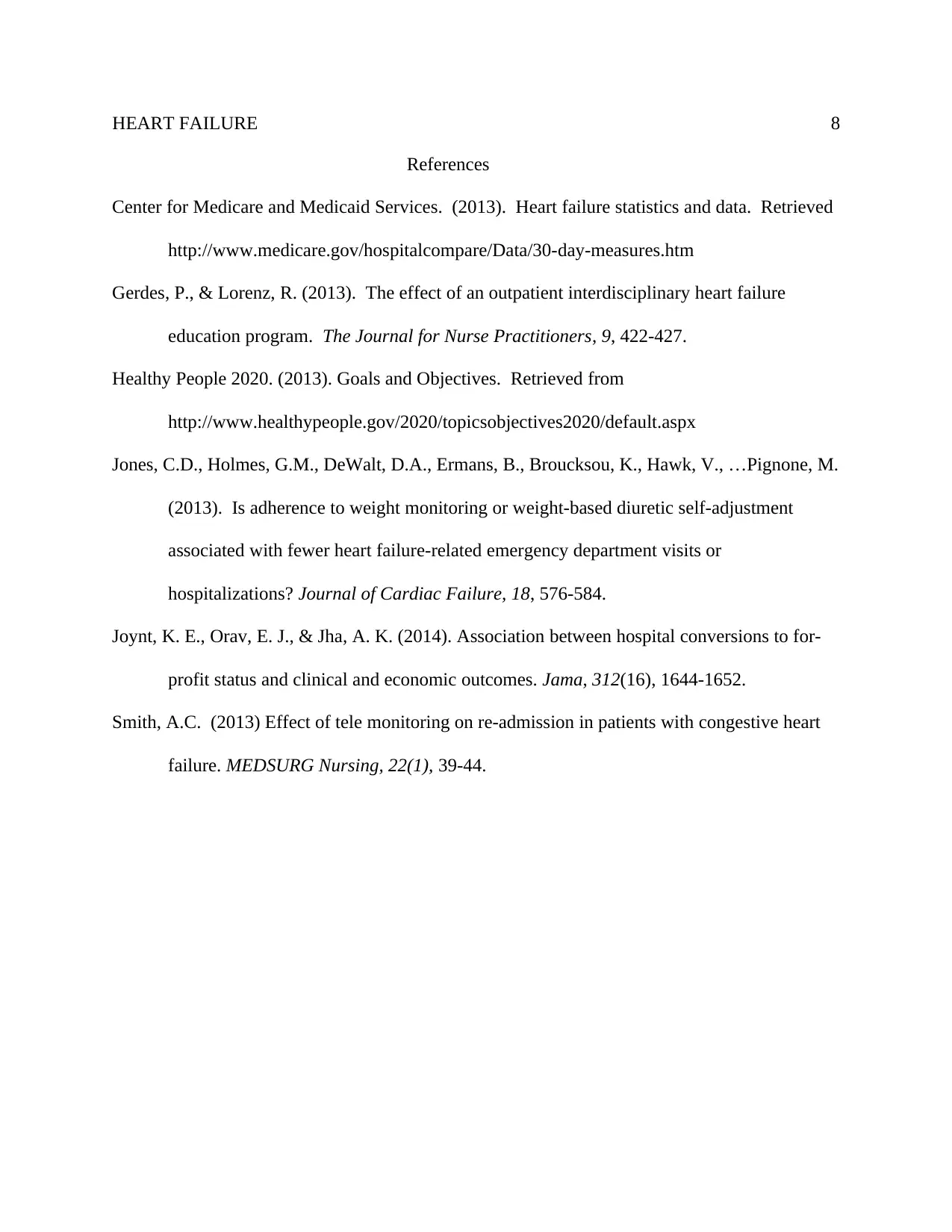
HEART FAILURE 8
References
Center for Medicare and Medicaid Services. (2013). Heart failure statistics and data. Retrieved
http://www.medicare.gov/hospitalcompare/Data/30-day-measures.htm
Gerdes, P., & Lorenz, R. (2013). The effect of an outpatient interdisciplinary heart failure
education program. The Journal for Nurse Practitioners, 9, 422-427.
Healthy People 2020. (2013). Goals and Objectives. Retrieved from
http://www.healthypeople.gov/2020/topicsobjectives2020/default.aspx
Jones, C.D., Holmes, G.M., DeWalt, D.A., Ermans, B., Broucksou, K., Hawk, V., …Pignone, M.
(2013). Is adherence to weight monitoring or weight-based diuretic self-adjustment
associated with fewer heart failure-related emergency department visits or
hospitalizations? Journal of Cardiac Failure, 18, 576-584.
Joynt, K. E., Orav, E. J., & Jha, A. K. (2014). Association between hospital conversions to for-
profit status and clinical and economic outcomes. Jama, 312(16), 1644-1652.
Smith, A.C. (2013) Effect of tele monitoring on re-admission in patients with congestive heart
failure. MEDSURG Nursing, 22(1), 39-44.
References
Center for Medicare and Medicaid Services. (2013). Heart failure statistics and data. Retrieved
http://www.medicare.gov/hospitalcompare/Data/30-day-measures.htm
Gerdes, P., & Lorenz, R. (2013). The effect of an outpatient interdisciplinary heart failure
education program. The Journal for Nurse Practitioners, 9, 422-427.
Healthy People 2020. (2013). Goals and Objectives. Retrieved from
http://www.healthypeople.gov/2020/topicsobjectives2020/default.aspx
Jones, C.D., Holmes, G.M., DeWalt, D.A., Ermans, B., Broucksou, K., Hawk, V., …Pignone, M.
(2013). Is adherence to weight monitoring or weight-based diuretic self-adjustment
associated with fewer heart failure-related emergency department visits or
hospitalizations? Journal of Cardiac Failure, 18, 576-584.
Joynt, K. E., Orav, E. J., & Jha, A. K. (2014). Association between hospital conversions to for-
profit status and clinical and economic outcomes. Jama, 312(16), 1644-1652.
Smith, A.C. (2013) Effect of tele monitoring on re-admission in patients with congestive heart
failure. MEDSURG Nursing, 22(1), 39-44.
1 out of 8
Related Documents
Your All-in-One AI-Powered Toolkit for Academic Success.
+13062052269
info@desklib.com
Available 24*7 on WhatsApp / Email
![[object Object]](/_next/static/media/star-bottom.7253800d.svg)
Unlock your academic potential
Copyright © 2020–2025 A2Z Services. All Rights Reserved. Developed and managed by ZUCOL.




